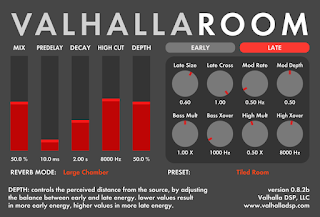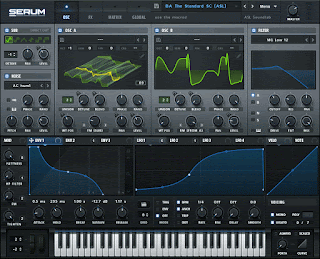ValhallaDSP ValhallaRoom v1.1.0 Incl Keygen-AiR
This latest release from ValhallaDSP follows the revitalised trend for algorithmic reverb. It offers four algorithms: Large Room, Medium Room, Bright Room and Large Chamber.
These claim to range from wide, smooth spaces to lush shiny reverbs, covering much ground in between. It’s available in AU, VST and RTAS formats for Mac, with a VST version for PC users in 32 or 64-bit flavours.
ValhallaRoom’s GUI is an intentionally no-frills affair. There are five vertical sliders on the left of the display for the most used parameters, namely Mix, Predelay, Decay, High Cut and Depth, with the reverb algorithm in use shown beneath.
The Decay control can be dialled up to a gargantuan 100 seconds, making huge soundtrack-style effects possible. If that’s your bag, then it’s worth knowing that stable-mate plug-in ValhallaShimmer is aimed specifically at creating these kind of massive soundscapes and FX patches.
The Depth control enables you to drastically change the reverb character by crossfading between the early and late reverb sections. Increasing it is like moving room mics further from the source to capture more room sound. It’s a great way to tweak an ‘almost there’ preset.
To the right of the sliders is a panel in which you can adjust the early and late reflections in more detail – the Early and Late buttons select which is active for editing. You can tweak the modulation parameters, the decay across three frequency bands and more here.
Hall of the gods
ValhallaRoom doesn’t feature any kind of graphical display to represent the generated reverb, which leaves you to focus on its sound. We found the GUI a bit large and cumbersome – an option to halve it in size would be welcome, or even a selection of alternative skins.
There’s currently no manual, but all the controls have automatic tooltips which show up on mouseover, so that’s not a big issue. ValhallaRoom’s presets always default to 100%, which will be a bonus for some and a pain for others – an update with a mix lock option should be out by the time you read this.
Patches to go
ValhallaRoom comes with a decent stack of presets, covering such reverb staples as room-style ambiences (which are great on rhythm guitars), effective gated reverbs for drums and spacious large halls, all the way up to huge, over-the-top FX patches like the Kingdome preset, which just cries out for long synth notes to be played into it.
The preset system follows the simple and effective dropdown menu route but would benefit from the sub-menu of the currently selected preset being highlighted. A/B compare functions would also make ValhallaRoom a lot more user-friendly and facilitate easier auditioning of presets.
On the upside, you can copy preset settings to your computer clipboard, enabling easy sharing and archiving of presets. Irritatingly, there’s no way to return a control to the preset value (or reset it to a default), so you have to reload whole presets if your tweaks don’t go to plan.
As mentioned, it seems that ValhallaDSP’s aim was to provide a versatile algorithmic reverb, and they’ve done a great job.
There’s a Lexicon influence evident and we were able to achieve similar results to both Lexicon’s PCM Native Reverb Plug-in Bundle and SSL’s classy X-Verb. This is especially impressive taking into account the enormous price difference.
Like most modern reverbs, ValhallaRoom’s algorithms are of excellent quality, ranging from surreal glassy tones to darker, more realistic chamber-type sounds. Even so, ValhallaRoom tends towards the hyper-real and lush, rather than gritty and realistic. You can even coax beautiful chorus effects from it by setting Depth to zero and increasing the modulation amounts.
While the sonics are very impressive, we still think there’s room for improvement in terms of functionality, so let’s hope a future revision takes the niggles mentioned onboard.
The fact that ValhallaRoom contains four different algorithms and is so competitively priced makes it a steal for anyone after a versatile reverb or something to complement their convolution collection.
If the Lexicons of this world are out of your financial grasp, you’d do well to reach for this instead.
Product Description
Unique Early reverb section allows user to dial in subtle and short bursts of early reverberation energy, as well as gated reverbs up to 1 second in length.
The Late section produces natural reverb decays ranging from 0.1 seconds to 100 seconds. The decay can be controlled in 3 adjustable frequency bands.
Both Early and Late reverb sections have adjustable modulation, to produce sounds ranging from lush chorusing, to subtle and natural long decays.
ValhallaRoom is true stereo. The Early and Late reverb sections are both stereo-in, stereo-out. The spread of energy between the stereo channels can be controlled over time, which helps preserve the input spatial image.
The GUI has been designed for easy navigation, and is inspired by Joseph Müller-Brockmann, NASA control panels, and Sesame Street.
Resizable GUI. Make it really big, or really tiny, or whatever suits you best.
A comprehensive preset browser makes saving, recalling and sharing settings easy.
Fully compatible with 32 and 64 bit DAWs (32/64 bit VST for OSX and Windows, 32/64 bit Audio Units for OSX, 32-bit RTAS for OSX and Windows, 64-bit AAX for OSX and Windows).
Twelve original reverberation algorithms:
Large Room. Designed to emulate big rooms with a wide spatial impression, with smooth “detuning” modulation.
Medium Room. Sparser than Large Room, with a more random modulation.
Bright Room. A lush, shinier-than-life reverb, with deep modulation and a somewhat slower attack.
Large Chamber. Smooth decay with consistent high echo density and subtle detuning modulation.
Dark Room. A hybrid between the grungy early digital reverbs and the modern algorithms found in ValhallaRoom, with reduced high frequency content, noisy yet lush randomized modulation, a HUGE spatial image, echo density ranging from grungy to dense while retaining clarity, and tons of mojo.
Dark Chamber. Similar to the original Large Chamber algorithm, but bigger and darker, with deeper detuning modulation.
Dark Space. A HUGE dark space, with a somewhat sparser early echo density and deep detuning modulation.
Nostromo. Deep, dark, echoing reverb. Very sparse early echo density, slow density build, random modulation, wide spatial image.
Narcissus. Dark, lush, wide, with random modulation that quickly builds into rich chorusing. The little sibling of Nostromo, but it is still big. Designed for low CPU consumption.
Sulaco. Dark with lush modulation, and a well-centered stereo image. The Late Size control can sweep the reverb from tight rooms to vast echoing spaces.
LV-426. A dark, deep space reverb, with the wide spatial image of Nostromo and Narcissus, but with a much higher initial echo density than either of those reverbs. LV-426 has a somewhat slower attack than the other modes, and has highly diffuse random modulation for lush decays.
Dense Room. Similar to Large Room, but with a denser distribution of early echos, and a tone that is brighter while still having the “darkness” of the Dark algorithms. Great for snare drums!
Download : http://ouo.io/VLx5fI



Komentar
Posting Komentar